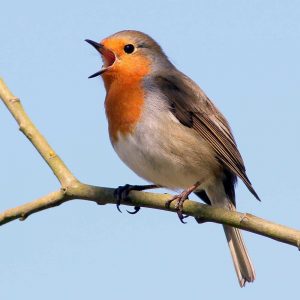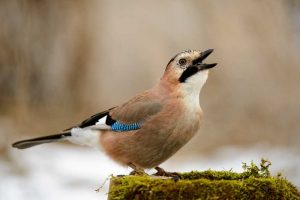I love listening to the birds in my garden almost as much as I enjoy watching and feeding them. My favourite sounds emanate from the course hedgerow early on a spring morning; it sounds alive and buzzing with bird conversation.
I wonder, do birds talk to each other; are they communicating or simply showing off their pretty voices because they can?

Birds have many ways of communicating within their own species and others. Some methods involve behavioural patterns although, calls and song are an effective way of conveying their message.
Most birds have multiple tones and calls, each denoting something different. It is universally believed that all birds respond to an alarm call from any bird, possibly to forewarn others of the imminent threat of predation.
As for general chit-chat or conversation, I need to dig a little deeper.
Table of Contents
How do Birds Talk to Each Other
Regular bird watchers recognise bird species by their call or song, but that isn’t the only noise each creature makes. They can change the tone, the frequency, even the type of sound to communicate with other birds.
Let’s use the pigeon as an example. When trying to woo a potential mate, they use the gentle cooing sound we are familiar with.
When the pigeon is stressed, their cry becomes a harsh grunting sound.
Imagine that other pigeons didn’t understand the difference between the two calls – there would be little procreation!
Bird Song vs. Call Notes
Bird song is repetitive bursts of the identical phrase. It features several notes and lasts a few seconds, longer if the bird is in the mood.
Male birds are responsible for the majority of bird songs and rely on them to attract a mate. At other times it’s a showy off tactic to announce to all other birds that he has entered the space and, boy, can he sing!
Call notes are much shorter sounds and more urgent. Most birds have several different notes they use to alert others of impending trouble. Cleverly, many have separate notes to warn if the predator is airborne or a ground threat thus, saving escape time for all other birds in the vicinity.
Call notes are an efficient way to locate a mate or offspring hidden in a deep thicket or forest. They are also used to communicate across flocks in flight, possibly to warn of predators or a good food source down below.
As a general rule of thumb, small birds make abrupt chirp, chip, or peep sounds.
Large birds tend to caw, screech, or click.

Why do Birds Use Their Voices?
The most obvious use of a bird’s voice, and the one humans find easiest to recognise, is the warning call. Much as we would scream and shout to warn others of danger, birds react in the same way. Different stages of the threat require louder, more urgent call; the most severe alarm often has a series of fast chirps tagged on.
As well as letting others birds know that there is a predator around, sparrowhawks, owls, and magpies also recognise the calls and might think twice about invading a nest for eggs or babies.
Birds, commonly the male of the species, use their song to attract a mate. They rely on the gentlest, prettiest chirrups of their repertoire to attract attention and impress their chosen female.
Another good use for a birds song is to claim and hold territory. Birdsong carries great distances on the wind, passing birds looking for territory to claim, hear the calls and understand that the space is already occupied.
Most bird species choose not to get into a fight, preferring to forewarn their presence.
Songbirds call their mates or chicks when they have become separated or to show them a food discovery. Their song also alerts humans that they are in the garden and the feeders could do with topping up!
Final thoughts
Birds talk to each other, not just those of the same species but also other families of birds.
It may not be a conversation that we recognise, but the birds obviously do.
Their ability to communicate and warn each other of danger is responsible for saving thousands if not millions of our feathered friend’s lives every year.
